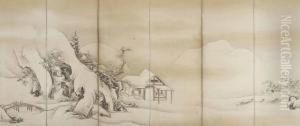Kaiho Yusetsu Paintings
Kaihō Yūsetsu, born in 1533 and deceased in 1615, was a distinguished Japanese painter and calligrapher from the Azuchi-Momoyama to the early Edo period. Though specific details about his early life remain elusive, Yūsetsu is recognized for his contributions to the development of the Kano school's painting style, one of the most influential schools in Japanese art history. His works are characterized by their incorporation of Chinese themes and techniques, which were highly fashionable and esteemed in Japan during his lifetime.
Yūsetsu's artistic achievements are reflective of the cultural and political transformations of his era. The Azuchi-Momoyama period was a time of unification and military conquest under powerful daimyos like Oda Nobunaga and Toyotomi Hideyoshi, followed by the establishment of the Tokugawa shogunate in the early Edo period. This era witnessed the flourishing of arts and culture, with patronage from the samurai class leading to significant developments in tea ceremony, Noh theatre, and painting.
In this vibrant cultural milieu, Yūsetsu excelled in the Kano school, which was known for its blend of Japanese and Chinese artistic traditions. The school's paintings often featured landscapes, birds-and-flowers, and scenes from history and mythology, executed with a refined elegance and attention to detail. Yūsetsu's work, in particular, demonstrated a mastery of ink wash painting techniques and an ability to convey depth and emotion through minimalistic compositions. His calligraphy also stood out for its boldness and vitality, reflecting the Zen Buddhist philosophy that influenced much of Japanese art at the time.
Despite his contributions, much of Kaihō Yūsetsu's life and the specifics of his works remain shrouded in mystery. Historical records and surviving artworks provide only a glimpse into his artistic endeavors and the esteem in which he was held by contemporaries and successors. Nonetheless, his legacy is evident in the enduring appeal of the Kano school's aesthetic principles and in the continued appreciation of Japanese ink painting and calligraphy.
